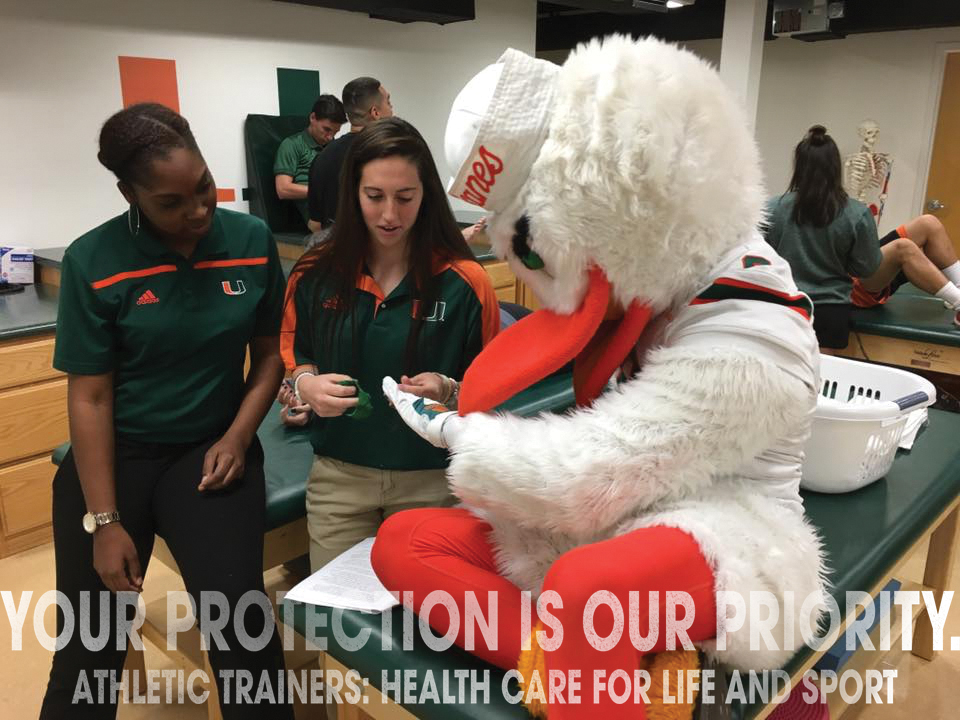What’s the first thing that comes to mind when you think about an athletic trainer? For many people, it’s the person that tapes the twisted ankle of a star basketball player or stretches out a cramped-up linebacker. How hard can that possibly be? Well, that description doesn’t even scratch the surface of an athletic trainer’s responsibilities. March is National Athletic Training Month, so there couldn’t be a more perfect time to shine a light on athletic-training students, who are some of the hardest-working students at the University of Miami.
Like the trainer’s work out on the field, the athletic training (AT) program itself goes unnoticed because it is so small. Right now, there are 16 sophomores, six juniors, and eight seniors in the undergraduate program, making it one of the smallest at UM. These students are led in part by Kysha Harriell, the athletic training program director. Harriell has been at Miami for two decades, beginning as an intern in athletic training before moving up the ladder to graduate student, to full-time athletic trainer, and finally to her current role.
“The curriculum and training is a blend of paramedic training, nursing and physical therapy,” Harriell said.
Athletic training is set apart from those disciplines because AT students can become certified in their field right after obtaining an undergraduate degree. UM’s program is one of the best in the nation, demonstrated by the fact that 94 percent of Miami students pass the certification exam on their first try – 12 percent higher than the national average.
More difficult than the exam is the path students must take to get there. Harriell calls athletic training the “unsung healthcare profession” because those who emerge from the three-year undergraduate program must be proficient in a wide range of disciplines. The list of what students must know includes anatomy, physiology, nutrition, therapy, psychology, orthopedic assessment and administration. That’s already a ton of knowledge, and that’s only half the list. Future athletic trainers need to know this information because they are the ones who will be providing care to athletes from the time they are injured until their return to health. Thus, every single element of a patient’s health must be recognized by trainers. Students need over 1,000 hours of clinical work before they can get certified, so it’s common to see many students working at various sporting events across campus. AT students come back to campus on July 31 every year, a full three weeks before most students, to work with the Coral Gables Fire Department to get recertified in CPR and other emergency situation training. All this happens before graduation. After getting their bachelor’s degrees, many students stick around to get a master’s in athletic training or go into similar health care programs in physical therapy.
So, how does all that work pay off for athletic trainers? Well, in short, handsomely. The students get to work in the Max Orovitz building, which houses its own professional training room, a room with training tables for hands-on learning in labs and a technology-equipped gym that can monitor various aspects of performance such as balance, force exertion and endurance. Students also have an inside track to getting jobs with professional teams since they get to spend three years working with the multitude of pro-caliber athletes who pass through Coral Gables on their way to the next level.
Harriell highlighted a few students doing this work who are earning experience with professional sports franchises before graduating. Seniors Makaylah Heyward and Gabby Arancio became the first two women in UM history to be offered internships with the NFL last summer. Arancio worked with the Miami Dolphins, while Heyward got experience with the Carolina Panthers and the Minnesota Vikings. Heyward was also offered a yearlong position with the Vikings, which she will take before moving on to physical therapy school the following year. Another senior, Matt Collazo, has worked with three pro teams: the Panthers, the New York Jets and the Pittsburgh Pirates. These students are all working in professional sports as 21-year-olds.
Miami graduates’ success in this field is further proven just by taking a short look across the NFL and NBA. About a dozen teams from those two leagues boast at least one UM alum on their training staff. This includes the heads of staff for the Cleveland Cavaliers and defending champions the New England Patriots. What if sports aren’t your cup of tea? There are opportunities for those individuals as well. Athletic trainers are needed in many professions besides sports.
“Not all athletes wear jerseys,” Harriell said.
Harriell said that some of her former students have worked in places such as Disneyland, NASA, UPS and Frito-Lay. The U.S. military has also begun to employ full-time athletic trainers. Dancers, postal workers and soldiers all face physical ailments just as basketball players do, so if a student wants to work in medicine but doesn’t want to be in a hospital all the time, athletic training is a potential career path.
Athletic training is a three-year program, so any current freshman who is interested can begin without the stress of starting behind. If a student is interested but not enough to make it a major, there is also the option of receiving a minor in sports medicine, a broader program that can serve as a foundation for an advanced degree in the future. The program is an opportunity for students to launch their careers in sports and medicine. These unsung heroes do so much more than stretching hamstrings and splinting fingers.







